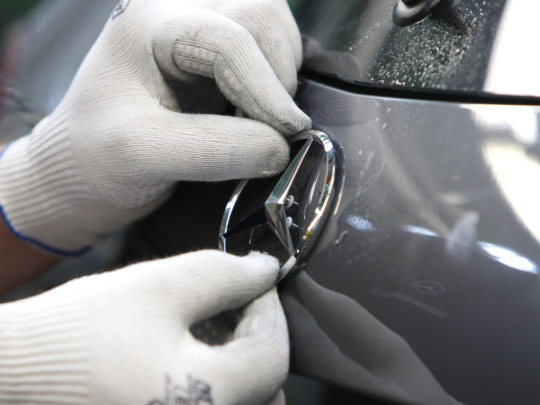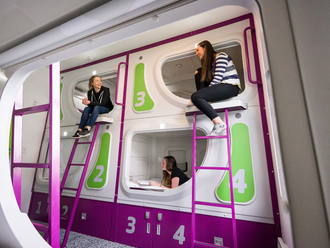
Don’t be fooled by the stereotypical austere German. Some 76 per cent of all German people describe themselves as hedonists and among 14- to 29-year-olds the figure shoots up to 88 per cent, according to a February survey by opinion research institute TNS Emnid.
The German definition of luxury is a little different when compared to other European countries, each of which has its own signature. The Swiss are very matter of fact and inclusive about luxury. The French sign off their flair with joie de vivre. The Italians flamboyantly parade their home-grown brands. The Germans uncompromisingly cross their technological t’s and finely double dot ä’s, ö’s and ü’s. Driven by domestic consumer demand, product innovation and significant investments, the German luxury market is charting its own course.
According to a study by consultants Roland Berger released in April this year, the fast growing market, which grew by 16 per cent last year, accounts for 0.3 per cent of the country’s gross domestic product (GDP). The export-driven market, which boasts brands such as Villeroy & Boch and A. Lange & Söhne, sees the Middle East as an important area of focus.
Distinctively German
“Up to now, Germany’s concept of luxury, particularly on the international level, has been very much coined by the strength and importance of its technology-driven automotive industry,” Dr Christian Kurtzke, Chief Executive Officer of Meissen Manufaktur, a 300-year-old German porcelain manufacturing company, tells GN Focus. “There is, however, a much broader [spectrum] of brands to discover in the German luxury industry that are shaping our luxury lifestyle, including outstanding brands in segments such as food and beverage, hospitality and fine arts.”
“From my perspective, the true German luxury players are not only the giant luxury conglomerates but rather small and mid-sized players with a focus on excellence in a niche,” adds Kurtzke.
Kurtzke is also the chairman of the newly established Der Meisterkreis — Deutsches Forum für Luxus or the German Forum for Luxury, which saw more than 40 luxe brands from diverse segments come together in Berlin last October.
Its members include the manufacturer of writing instruments, watches, jewellery and leather goods, Montblanc Deutschland, watchmakers A. Lange & Söhne, leather goods major Comtesse, kitchen appliance maker Gaggenau, department store KaDeWe, camera-maker Leica, accessories company Porsche Design, hotels such as the Adlon and Brenners Park-Hotel & Spa, vintners such as Robert Weil and international luxury brands such as Chanel, Dior and Estée Lauder.
Similar French and Italian organisations, Comité Colbert and Altagamma respectively, were established much earlier, followed by the UK’s Walpole. The new initiative is already assimilated into the larger European Culture and Creative Industries Alliance (ECCIA). Armando Branchini, president of the ECCIA, says, “An appropriate representation of the specific contribution that Germany makes to European luxury culture was long overdue.”
Domestic consumption
While networking is its stated mission, the forum also focuses on domestic consumption. “Germany is one of the most important luxury markets in Europe,” says Kurtzke. “A recent study carried out by Bain and Company for Altagamma revealed that in comparison with Italy, France or the UK, the German luxury market is much more determined by domestic buyers rather than by increasingly global luxury tourists.”
A study by strategy consulting firm Roland Berger entitled 2011 – The German Luxury Market is Growing Rapidly released in April last year showed that Germany has the biggest potential in Europe. The country’s luxury market grew by 16 per cent to €12.9 billion (about Dh61 billion) in 2011, exceeding the industry’s global growth rate of 9 per cent.
The leader in the segment was not automobiles but watches, jewellery, fashion and accessories, which were collectively up by more than 20 per cent as compared to 2010.
The German luxury car market did grow significantly by 19 per cent and remains the largest luxury segment with a volume of €5.1 billion. Luxury carmaker Daimler has, in fact, reduced its earnings forecast for next year, from $6.52 billion (about Dh31 billion) in operating profits it recorded in 2011, while Porsche has said it is going to reduce production.
Tourists with wallets
According to the study conducted by Bain and Company for Altagamma, the consumer-led growth was augmented by rising numbers of well-heeled tourists visiting German cities and the expansion of product ranges by luxury manufacturers. Per capita spending by Chinese visitors rose by 40 per cent last year and Russian tourists increased their spending by as much as 60 per cent. “The expansion of the luxury hotel industry in Germany will significantly support this development in the coming years,” says Philip Beil, Principal at Roland Berger Strategy Consultants.
“Suppliers again expect significant growth in 2012 and are planning to support it by investing in their own stores, boosting marketing and hiring new staff,” states the study conducted by Bain and Company.
“No other European country can compete with these growth rates,” says Beil. “Next to the Asian growth countries, Germany remains one of the expanding markets for the major luxury companies.”
The luxury goods market currently accounts for only 0.3 per cent of the country’s GDP, compared to other markets such as Italy, France, the UK, the US or Japan, where market share averages of 0.6 per cent.
Businesses are investing in this growing market — local news media reports that the number of luxury brand boutiques in Germany rose by about 30 per cent between 2007 and 2011.
“Our largest market by volumes is Germany,” says Geoffrey Nejman, Chief Executive Officer of Parfums M. Micallef, a niche French perfume company. In a world cluttered by mass-produced branded perfumes, Nejman says that his smaller company first found acceptance in German perfumeries, which wanted to differentiate themselves from large department stores.
The Roland Berger study stated that in 2008 only 28 per cent of affluent consumers said they liked to buy expensive things. By 2011, this number had risen to about 33 per cent.
International footprint
While keeping to the strengths of their German roots, aesthetic brands still confess to expansion plans across the world. Most major brands have ambitious plans for the Middle East and are doing much to customise the offering.
“Our plan is to establish bath and wellness flagship stores or further tableware shops in department stores in malls, together with our local partners and distributors. We would like to target the high-end and premium retail customers and work on the upscale residential and hospitality projects,” Jessika Ranch, the International PR Manager at Villeroy & Boch, tells GN Focus.
The company’s hotel and restaurant division has already worked on exclusive tableware for the Emirates Palace in Abu Dhabi. Its bath and wellness division cites residences on The Palm.
“We are particularly looking into fast-moving emerging markets with superior growth, with an initial focus on Asia,” says Kurtzke. “Meissen is currently setting up its distribution network across the Middle East.”
A. Lange & Söhne, another founder-member of Der Meisterkreis, recently opened its largest boutique in the world in Dubai. “The UAE is indeed a country of key significance to us,” says its regional brand director Matthieu Dupont. “Dubai is significantly important — it is dynamic and fast moving with an extensive range of nationalities and many horological enthusiasts. It is recognised as not only a regional but also an international retail epicentre and is excellently positioned in terms of luxury offerings; hence our decision to open our regional flagship store here,” Dupont concludes.







